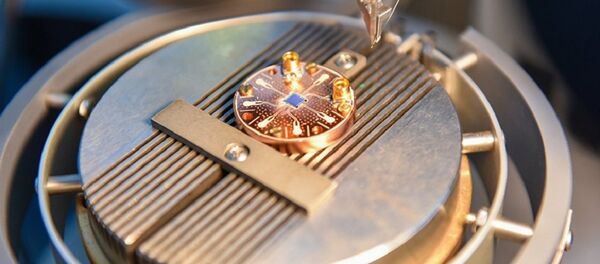What are these structures and why they are so important for people? Why were they awarded Nobel Prizes in the past? How are they designed today? How will heterostructure-based electronic devices evolve in the future?
In the beginning were electrons and holes
Semiconductor diodes are a different matter. These devices operate as real valves, letting EC flow in just one direction, something achieved by a combination of different materials.
This is the juncture of two or more different substances that lies at the base of an electronic instrument. The so-called p-n junction is made possible by a juncture of, for example, two differently doped regions in the same semiconductor.
READ MORE: WhatsApp Tests 'Forwarding Limit' Feature to Curb Fake News in India
Adding an impurity to a pure semiconductor crystal can increase its conductivity by several orders of magnitude. Depending on the combination, its EC carriers will be either negatively charged electrons (n-type) or positively charged holes (p-type).
Despite the simplicity of the production process, the p-n transitions have shortcomings of their own, such as instability at high temperatures. High temperatures generate electrons and holes even in a pure semiconductor. This means that eventually, the crystal will "forget" that it has impurities and the diode will start passing EC in both directions, resulting in device failure. Moreover, p-n junction based lasers can function only at liquid nitrogen temperatures.
Heading towards a Nobel Prize
It is the limits of the p-n junctions and the general need for semiconductor lasers to function at room temperatures that compelled scientists to create heterojunctions and heterostructures.
A heterojunction combines two crystalline substances, with a pure, ideal juncture, without cracks or other defects, said Yury Sibirmovsky, the engineer at the Institute of Nanotechnologies in Electronics, Spintronics and Photonics (INTEL) at the National Nuclear Research University MEPHI.
"The difference in properties at such an interface produces several useful phenomena. Unlike the p-n junctions, heat has a weak impact on heterostructures' properties," he explained.
READ MORE: 27 Satellites in 3 Years: Indian Private Sector Shifts Focus to Space Projects
The typical semiconductors — silicon, germanium, AIIIBV compounds (such as gallium arsenide (GaAs) or indium arsenide (InAs), as well as InP and GaN) — and their ternary solutions can be combined to produce a wide range of variations in the electronic and optical properties of instruments and devices.
They designed a double heterojunction laser, where both light-emitting electrons and the laser beam itself before it leaves the crystal, are locked within a thin central layer.
This design makes it possible for semiconductor lasers to run continually at room temperatures. Currently, these lasers are used in a broad range of devices, including DVD disc drives and players.
READ MORE: Tech Giants are Just Going to Pass the Cost Onto Consumers — Researcher
In the 1960s, it seemed improbable that ideal heterojunctions would ever get beyond the experimental stage. But Alferov and his colleagues managed to select the GaAs/AlxGal-xAs system that became the basis for both lasers and the low-noise transistors used in smartphones to amplify the signal.
The MBE method: At the junction of science and art
Owing to the super-high vacuum and the increase of nearly one atomic layer per second, MBE makes it possible to control the chemical composition with high precision and secure atomically smooth boundaries between layers in heterostructures.
"Epitaxy offers immense freedom in controlling layer compositions and combining substances. Here science verges on art since you can design an infinite number of different heterostructures using several chemical elements," Sibirmovsky said.
Heterostructures in electronics
Heterostructures figure importantly in efforts to develop high electron mobility transistors (HEMT) used on a broad scale in microwave electronics (satellite communications systems, radar, mobile devices, etc.).
But the size of InAs and GaAs crystalline cells is not the same. The expansion of pure InAs on GaAs bases would cause fracturing and makes a working instrument a problem. Moreover, the bases of InAs itself are insufficiently stable.
READ MORE: Russia's Manufacturer of Customer Service Robots Entering US Market — Company
Therefore, an important task facing heterostructure physics is to develop buffer layers that make it possible to grow a defect-free InyGa1-yAs layer with a possibly large share of InAs. These are called pseudomorphous HEMT structures or PHEMT structures, which currently support the majority of commercial microwave amplifiers.
Their study has helped scientists from INTEL and the Institute of Super-High Frequency Semiconductor Electronics at the Russian Academy of Sciences to discover that the best effect is produced by a graded, rather than smooth, modification of combinations of super-lattices, that is, narrow layers several nanometers thick.
Quantum design is the solution
To address this and other issues, the Molecular Beam Epitaxy and Nanolithography Laboratory at INTEL (head Senior Lecturer Ivan Vasilyevsky) suggested a quantum design for heterostructures based on a transition to combined functional layers.
"The narrow conductor layers are ‘quantum holes' for electrons. Electrons are captured by these narrow layers, with their properties changed in accordance with the laws of quantum mechanics. If the changed chemical composition of a homogeneous quantum hole fails to improve a material's characteristics, the solution is to complicate the design by adding various heterogeneous nanolayers or super-lattices," he said.
READ MORE: Researchers Сreate New Type of Qubit for Quantum Computers
The mobility of electrons can be effectively increased without the loss of high concentration with the help of the InAs nano insert in the quantum hole or A1As outside it, he added.
"The laboratory has designed and grown hundreds of InGaAs-based HEMT, PHEMT, and MHEMT heterostructures and has thoroughly studied their properties, something that has aroused much interest in the world's research community and made MEPHI a leader in terms of the number of publications in this area. Our results have been tested in practice, specifically in our research to develop low-noise microwave transistors and other instruments," Vasilyevsky said.
However, much more research is needed to create high-quality and cost-effective instruments based on this. It is symbolic that the recent Nobel Prizes in Physics were awarded for research in graphene (2010) and gallium nitride (2014).
READ MORE: Russian Scientists Create 3D Printer So Precise It's Able to Print Human Organs
MEPHI is not overlooking this area. In 2018, a number of young INTEL researchers were awarded the Moscow Government Prize for developing a GaN microwave amplifier with a graphene-based heatsink.
The arsenides- and phosphides-based quantum design of heterostructures may prove a beneficial alternative to new materials. It does not require expensive bases, new crystal growth methods or more sophisticated technological processes.








